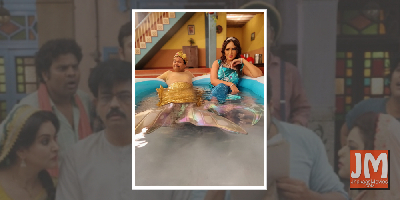 Aan Tiwari honoured with Best Child Actor award for Baal Shiv
Aan Tiwari honoured with Best Child Actor award for Baal Shiv Ghategi rahasymayi ghatnaye!
Ghategi rahasymayi ghatnaye! Amazon Prime Video unveils the 2021 Festive Line-up; brings a heady mix of Indian and International titles on the service
Amazon Prime Video unveils the 2021 Festive Line-up; brings a heady mix of Indian and International titles on the service Release: Music video of, Yeh Haalaath, from Mumbai Diaries 26-11
Release: Music video of, Yeh Haalaath, from Mumbai Diaries 26-11 Bhumi Pednekar feels she shares feel-good value with Akshay Kumar on screen
Bhumi Pednekar feels she shares feel-good value with Akshay Kumar on screen
Industry in a limbo (Column: B-Town)

BY VINOD MIRANI
Where does the industry stand today? Nobody knows. All three sectors of cinema making are at sea: Production, distribution and exhibition, not to mention the auxiliary offsprings of cinema, the OTT streaming platforms as well as the other mediums like television and the stage.
Over the last seven months since the Covid-19 lockdown came into effect, the whole equation, rather the idea of providing entertainment, has been changing rapidly.
Over the period, the film industry has gone through many phases. Films did the rounds of a film circuit leisurely, beginning with the major cities of the circuit. For example, in Delhi-UP circuit there would be the premiere release of a film in a few cinema halls in Delhi, along with other cities of UP like Kanpur, Lucknow, Agra and so on. In Mumbai circuit with, say a dozen cinemas in Bombay as it was known, along with one or two cinema screens each in cities like Pune, Kolhapur, Sholapur, Sangli, and Satara, as well as Ahmedabad, Baroda, Surat, Rajkot, Jamnagar and a few more in Goa and North Karnataka.
A film was expected to cover a major circuit in a period of 18 months to determine if it was an earner or a loser! A lay reader would never guess what were considered as opposition to a film in a small town. It could be a magic show or a circus in town, besides the films playing in other cinemas. All these affected a film's collections! Then, of course, there were periods like Ganesh festival, Navratri cum Ram Leela, annual exams and so on.
As technology developed, so did the challenges to the theatrical film business. First came television in select cities of India. It was a minor hurdle. But with the introduction of colour television, the main purpose was to propagate and further Government agendas, like the Films Division did in cinema halls all along. The irony was that the television programmes that affected a film's business were the ones provided by the film industry itself! These were feature films and the slots filled by film songs and such content.
The liberal economic policies introduced in 1991 by the government opened the floodgates for private television channels to get into business. As of today, there are estimated to be about 1000 TV channels in India. The television invasion was good news as the filmmakers annexed themselves to this small screen medium and took to making serials. Also, a lot of not-in-demand or out-of-work actors found work in television. Gradually, it became an extension of the film industry.
Then came the real challenge, the video. The medium of video players would not have been a great problem were it not for the piracy that it brought along. The various film associations that could not control its producers providing content to television, had no means (also, no inclination) to control piracy, because every producer lived for that one Friday on which his film released. Thereafter, it was not his problem, so what if his own film was being shown illegally on cable TV?
That was when anywhere from 180 to 200-odd films were made in Hindi alone, out of which 80 per cent found takers and made it to cinema halls. The causalities were high but so was the number of new investors arriving. The industry went on merrily. The industry always attracted new prospect hunters -- the glamour-struck as well as anybody who had made a few extra bucks from here and there.
But then came the foreign studios. The very people who made films in Hollywood and sent a couple of used release prints to India much after the film's international run was over, to screen at a few cinemas owned by them in metros like Mumbai, Delhi, Kolkata and Chennai. A limited niche audience lapped up those spent Hollywood films.
There was an embargo on how much of their earning they could remit back to the parent office abroad. India was not worth doing business with! Again, the economic reforms in 1991 changed all that.
Foreign studios from various countries set sight on India and the Indian film industry. Thus came the corporate style of filmmaking! The multiplex chain holders, mostly Indian-owned, complemented them though neither knew the business the way it needed to be done in India. Thanks to them, film budgets hit the sky and multiplexes took the lion's share. They literally ran the film trade and the maker had no say!
Now that the corporate backers have left the scene and corona has put all business on a pause including the cinema halls, the OTT streaming platforms have sprung up in dozens. Now, the high-end cinema chains have no content to show! No content, no audience and yet, they insisted on resuming business. Forced to screen old content that has already been made available on OTT, the footprints have been meagre.
From week October 16 to 22, the Chanakya Delhi properties have performed 43 shows and sold 97 tickets to collect a net box office of Rs 7,923 with occupancy rate of 0.91 per cent! In Chandigarh, Central property performed 51 shows, sold 102 tickets and collected about Rs 11,600 which works out to 0.66 per cent. Other chains are faced with a similar situation.
Talking of NCR, the situation is not any more encouraging. Ambience Gurgaon, for instance, performed 66 shows in its 12 screens and sold 289 tickets to collect Rs 26,111 which works out to some 2.25 per cent.
Looking East, Avani Kolkata played 64 shows spread over 13 films, sold 616 tickets to collect Rs 78,000 at 3.2 per cent, not to forget it was the festival period in Bengal.
Coming to the most lucrative circuit for the Indian film trade, Western India (Maharashtra reopened only this week on), Acropolis, Ahmedabad, performed 13 shows across its nine audis with 127 admits for a sum of Rs 4,600/ at 5.6 per cent.
Similarly, the Iris chain in Surat, played 33 shows across its five screens to sell 143 tickets against Rs 11,800 for a meagre 1.9 per cent.
The story at Aura Bhopal was no different. Against 39 shows performed across its five screens, it sold 72 tickets to collect Rs 6,550, which works out to 0.61 per cent!
This is the sample of the mighty multiplex chains that called the shots. From a buyer's market, they tried to turn it into the seller's market! They failed to understand that a film drew the audience, not a cinema hall.
Cinemas lobbied hard for reopening after months of lockdown. Many countries in Europe, where lockdown was lifted and the cinemas allowed to function are resorting to a second lockdown. To add to that, production activity of films has not started in full swing yet.
It is no different for the television entertainment channels. The ratings of the popular programmes like "Comedy Nights With Kapil" and "Kaun Banega Crorepati" are hovering between 1.8 and 1.4, respectively. Meanwhile sitcoms and family programmes are reclaiming top positions, but slowly.
As for OTT platforms, they may have added a huge number of new subscribers and are the main topic of debates and discussions on social media, one can gauge that on offer are mostly mediocre fare, save for a flash-in-the-pan programmes once in a while, like "Special Ops" and the recent "Scam 1992: The Harshad Mehta Story".
"Arya", "Delhi Crime", "The Family Man", "Jamtara", "Asur", "Metro Park" are some of the 150 or so streaming programmes that did well along with some others, which were noticed. These were "Undekhi", "Raktanchal", "She", "Chippa", "Abhay", "Poison", "Selection Day", and "Stories Of Rabindranath Tagore".
There were also some where the first season made impact while season two disappointed. These were "Sacred Games", "Mirzapur", "Breathe", "Inside Edge", and "Four More Shots Please". Then there is this platform, TVFplay (The Viral Fever) that uses YouTube, which has content like "Permanent Roommates", "Kota Factory", and "Panchayat" and they have built a loyal viewership. But this percentage is small. As for films acquired by the OTTs, nothing seems to have caught the fancy of viewers so far.
The main attraction for OTT subscribers is that content from all over the world is available to them.
A huge transition happened to the film industry as more and more mediums came up to cater to the entertainment seekers, and an entertainment industry emerged from what was earlier the film industry. As things stand at present, this industry is in a limbo. It is not easy to figure out what is happening, who will swim and who will sink!
(Vinod Mirani is a veteran film expert and box office analyst. The views expressed are personal)
Tags: Cinema, Showbiz, Lifestyle, Fashion, Quote Unquote








